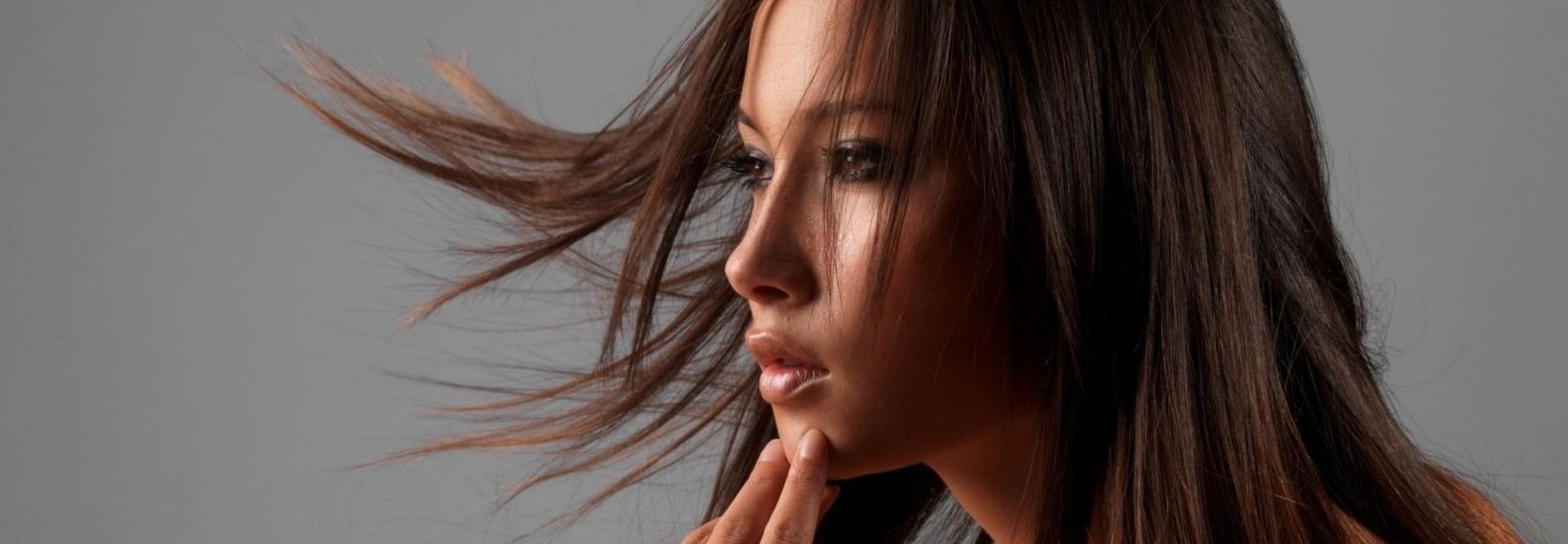
13 Care Tips After Rebonding Your Hair
For many Asians, the struggle with naturally curly or frizzy hair is real. Too many times have we tried to ready ourselves to head out, only to find our tangled locks refusing to loosen up or the frizz simply will not be tamed. Often those with frizz or natural curls are wishful for straight strands because of the ease with which they can be managed.
The easiest remedy for this concern is to head for chemical processes that can transform our knotted strands into smooth, uncurled locks. One of these is rebonding. This technique is a blessing because it is the quickest method for those who long for straight tresses but are not born with it, just like you and me. The end result, of course, is poker-straight locks.
What Is Rebonding?
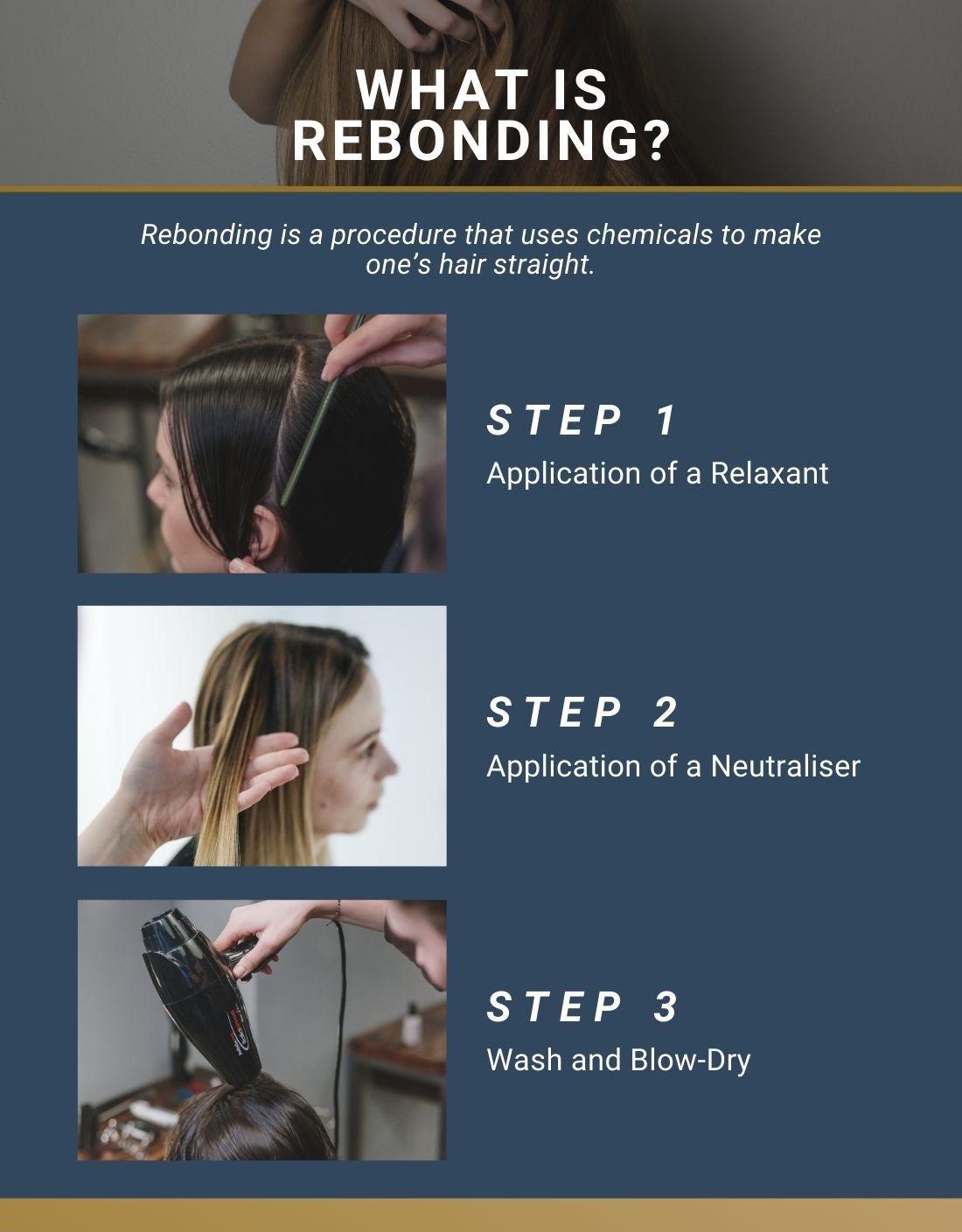
But first, what is rebonding? Well, rebonding is a procedure that uses chemicals to make one’s mane straight. This technique originated from Japan and rose in popularity in Singapore in the early 2000’s. New variations have since emerged, but still share similar steps. Here’s an overview of how it works:
1. Application of a Relaxant
The first step of this procedure is to break down the natural bonds in your locks with the help of a strong straightening chemical lotion called a relaxant. Your stylist will then press each section of your tresses with a hot iron.
2. Application of a Neutraliser
Afterwards, neutralisers are applied to help the loosened bonds restructure themselves again. This is the moment new bonds are created, hence the name. Your long locks will hereafter lose their ability to naturally curl up due to its altered physical structure.
3. Wash and Blow-Dry
Finally, your tresses will be washed, blow-dried, and styled as per your preference. The stylist will finish off the new look with a conditioning serum to protect your locks. Getting your mane rebonded is, of course, one of the most straightforward procedures in safe hands. A couple of hours in our salon with our trusty stylists, and voila, you have rebonded hair! But here comes the trickiest part — aftercare.
Why Is Aftercare Important?
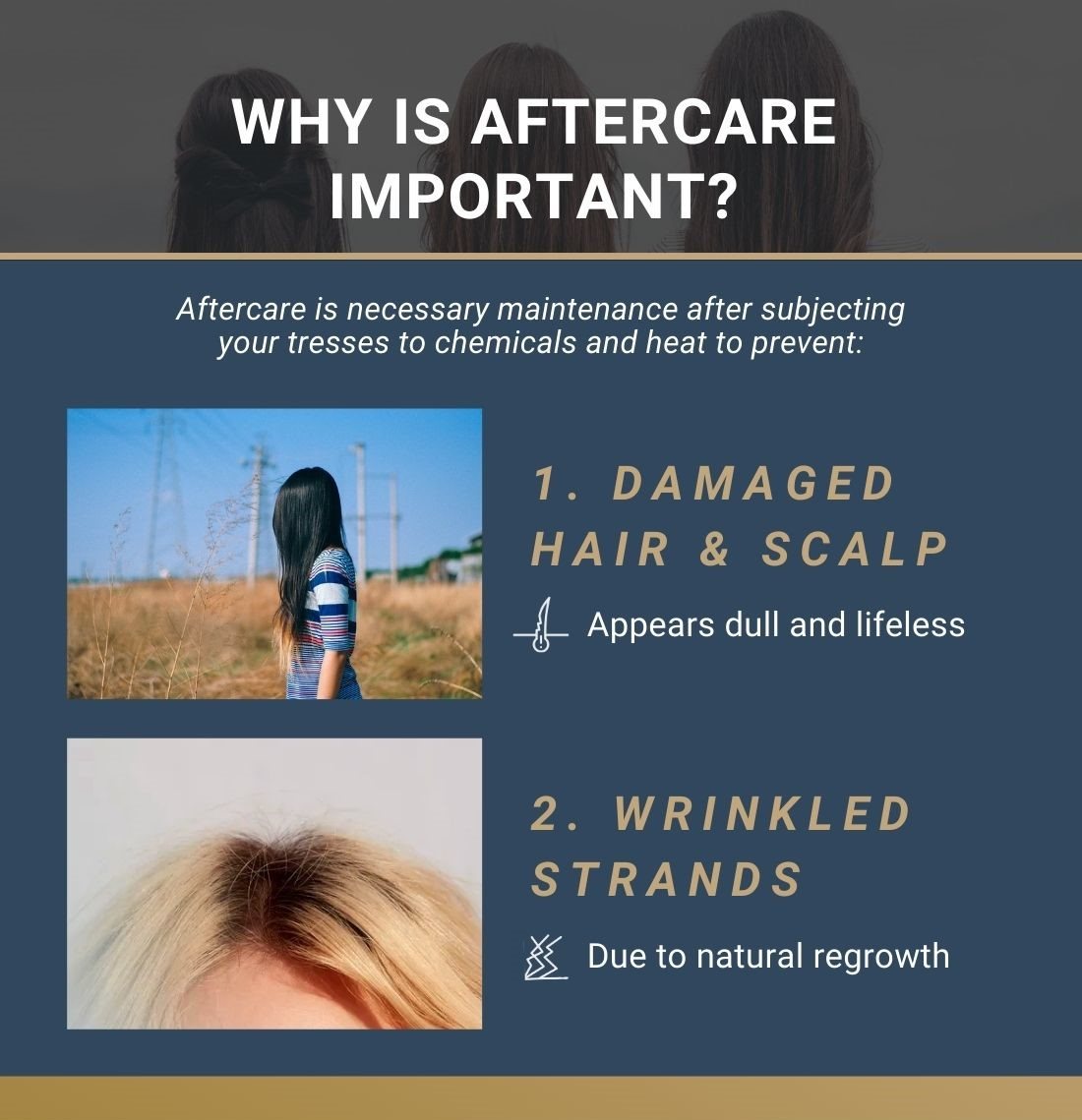
The rebonding process can be intense on your strands. A proper aftercare routine helps to maintain the strength and quality of your tresses, therefore ensuring the effects last long. Depending on which type of technique you choose to do — be it straight rebonding or soft rebonding — these will differ:
- Type of chemicals
- Temperature of heat
- Intensity of treatment
Straight rebonding uses higher heat and more intense chemicals to tame fuzziness. On the other hand, soft rebonding uses milder chemicals and a lower temperature to reduce frizz. Regardless of technique, however, you’ll be subjecting your tresses to chemicals and heat. Therefore, you should ensure that all the effort you take to have your tresses transformed is worth it. If you skip out on taking care of your mane, the results of this treatment may not last as long as they should.
1. Damaged Hair and Scalp
Excessive usage of heat and chemicals may dry out your tresses and scalp. Moreover, the coarser one’s strands are, the more vulnerable they are to breakage, hair loss, and split ends. As such, without enough nourishment, your locks will lack their usual shine. So it is very critical to protect your locks from damage.
2. Wrinkled Strands
Over time, chemically treated strands will show signs of wrinkling if the moisture they lose during the rebonding treatment has not been restored. On top of that, regrowth is natural — new strands will, sooner or later, sprout out from your existing roots. If your natural locks are curly or frizzy, those fine, wispy baby hairs will return before they are due.
3 Care Tips for the First 3 Days
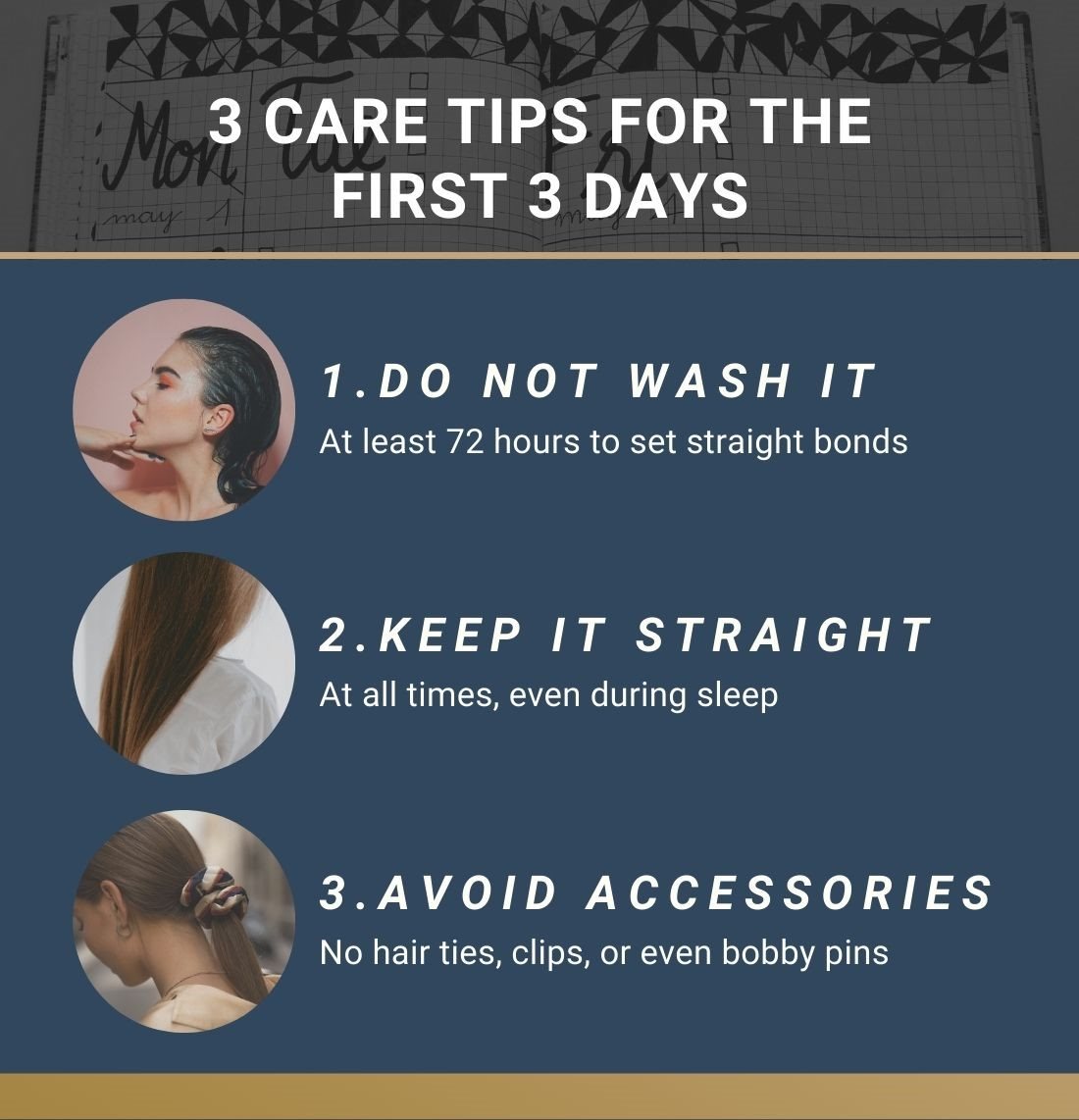
Now that you know how important it is to care for your rebonded locks, let’s move ahead to find out what we should do to prevent the above-mentioned.
Firstly, before you step out of the salon, ensure that your scalp has been slathered with enough nourishing serum to last you for the next three days. A good stylist would take all the necessary measures to moisturise and care for your tresses and scalp.
Once that’s done, follow these three tips religiously:
1. Do Not Wash It
There is one very important thing that you must keep in mind: no matter what happens, ensure that water does not touch your tresses. Now do you understand why we asked you to leave the salon with a promising amount of moisturising serum on your locks? Yes, they need at least 72 hours or three days to settle into their newly bonded structure. Washing them before that happens will leave you with sub-optimal results.
2. Keep It Straight
This is indeed the hardest to follow, but do ensure that your tresses are always kept straight. Do you have a habit of tucking loose strands behind your ear? If so, then it is time to say goodbye to that. Your tresses should also remain straight whenever you sleep. This has to be done with some deliberate effort for the first three days. The best option is to lie down on your back straight and fling the strands backwards off the pillow.
3. Avoid Accessorising
Thirdly, do not use hair ties, clips, or even bobby pins. These accessories might leave your newly structured locks with creases, and you want to avoid that at any cost. If your job or school demands neatly tied or pinned hair, schedule your appointment on a Friday to leave your tresses untouched over the weekend.
6 Tips for the Next Few Months
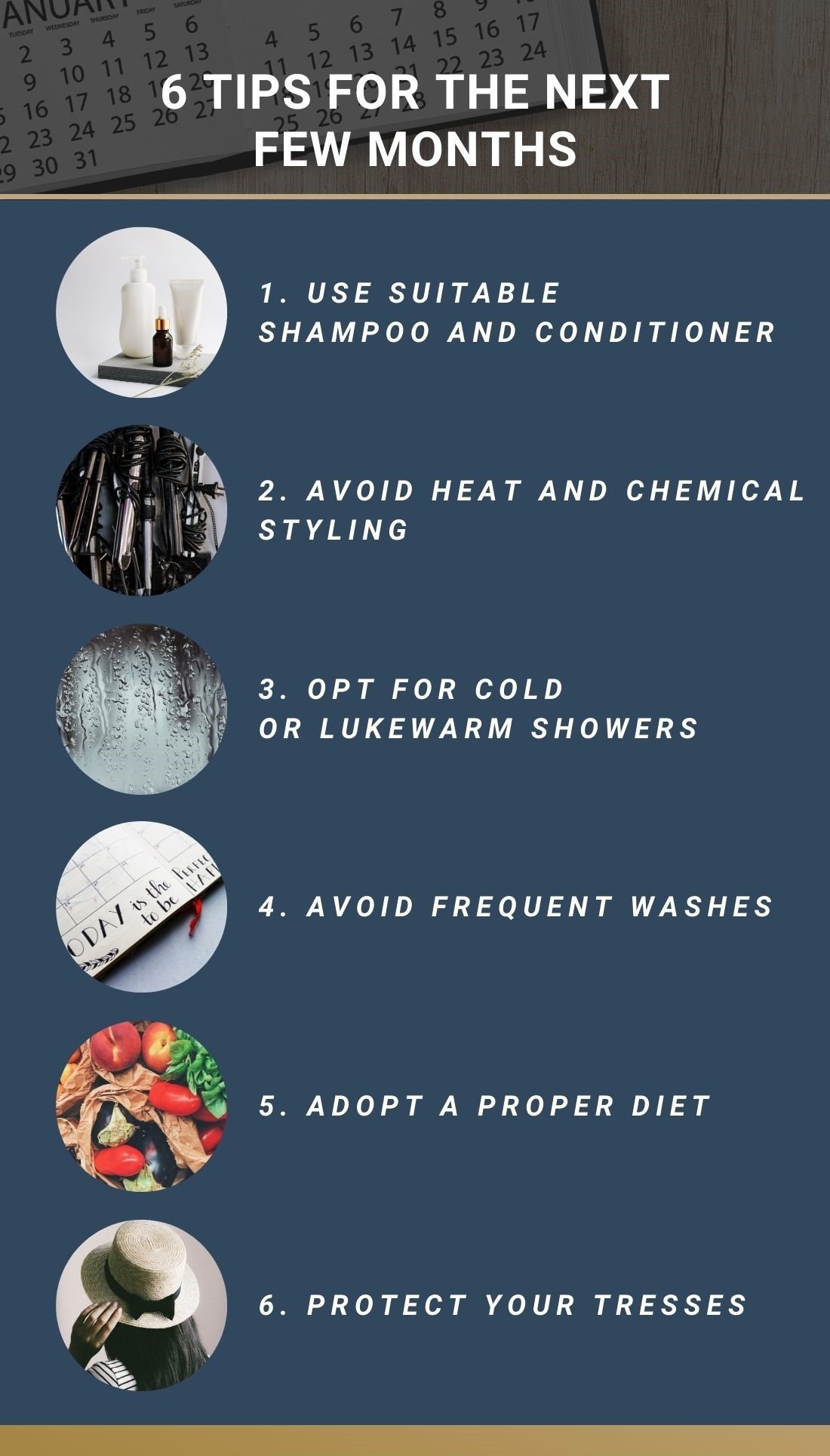
Here comes the most difficult part. You need to commit to the tips in this section to care for your new look for the next few months. How religiously you care for your tresses during this time will determine how healthy it will remain.
This is where many of us tend to slack due to a lack of proper routine to care for our locks. Or perhaps we might end up agreeing to new commitments that shrink the time that we have for ourselves. Other times, we might just simply get over any momentary joy that once came with newly straightened locks and stop caring.
This is where many of us tend to slack due to a lack of proper routine to care for our locks. Or perhaps we might end up agreeing to new commitments that shrink the time that we have for ourselves. Other times, we might just simply get over any momentary joy that once came with newly straightened locks and stop caring. But if you’re 100% committed to your new ‘do, take the time to consider these tips:
1. Use Suitable Shampoo and Conditioner
After the first three days have passed, you may wash your tresses. Ensure that you use a mild shampoo that is specially formulated for chemically treated locks. After washing it, slather on some good protein-rich conditioner. Wait for a few more extra minutes till it soaks up a good amount of moisture before washing the conditioner off. Finally, use a leave-on conditioner to keep it free from tangles, and finish off with a wide-tooth comb. Our salon does recommend suitable products to use after rebonding, so don’t forget to check with your stylist on this.
2. Avoid Heat and Chemical Styling
Your locks have already been styled. Therefore, avoid using any heating tools that may damage them and keep your curlers and blow dryers inside your drawers. If using a blow dryer is a habit you cannot quit, you should use it only on the cool setting. You should also never use hairspray on, apply gels, or wax your straightened locks. It may seem as though they make your life easier as they can keep your tresses in place, but their chemical content can damage and ruin your lustrous locks. Unless your hairstylist has endorsed them, they’re just not worth it.
3. Opt for Cold or Lukewarm Showers
Cold water helps seal in your cuticles and keep your shafts nourished by preventing loss of moisture. This way, you will preserve your hair’s new shine. If you are not used to cold showers, shower with lukewarm water instead. But avoid showers that are too hot.
4. Avoid Frequent Washes
Many of us wash our tresses regularly to keep them fresh and clean, but it is advisable to reduce the frequency after rebonding. Keeping it below three to four washes per week is ideal. If you need to, opt for dry shampoo to buy yourself some time in between showers.
5. Adopt a Proper Diet
Mineral-rich food plus physical maintenance equals to fresh-looking tresses. For your tresses to glow, what you eat matters more than what you smear them with. The overall health of it highly depends on what you include in your diet. While treatments are equally important for their conditioning, the nutrients you consume keep your roots strong and your hair healthy. Include fruits, vegetables, and protein-rich food to your meal plan. Avoid eating junk food excessively. All these changes will determine how strong your tresses are.
6. Protect Your Tresses
Protect your tresses from the elements. Your best friends, hereafter, are none other than scarves, hats, and umbrellas. You must keep your locks safe from harsh environmental factors, such as pollution, rain, and the UV rays of the sun. Most importantly, never get caught in the rain. If you do get your tresses wet, wash them as soon as you get back home. Rainwater contains a massive amount of pollutants and salts that may cause significant damage.
4 Tips to Protect Your Rebonded Locks in the Salon
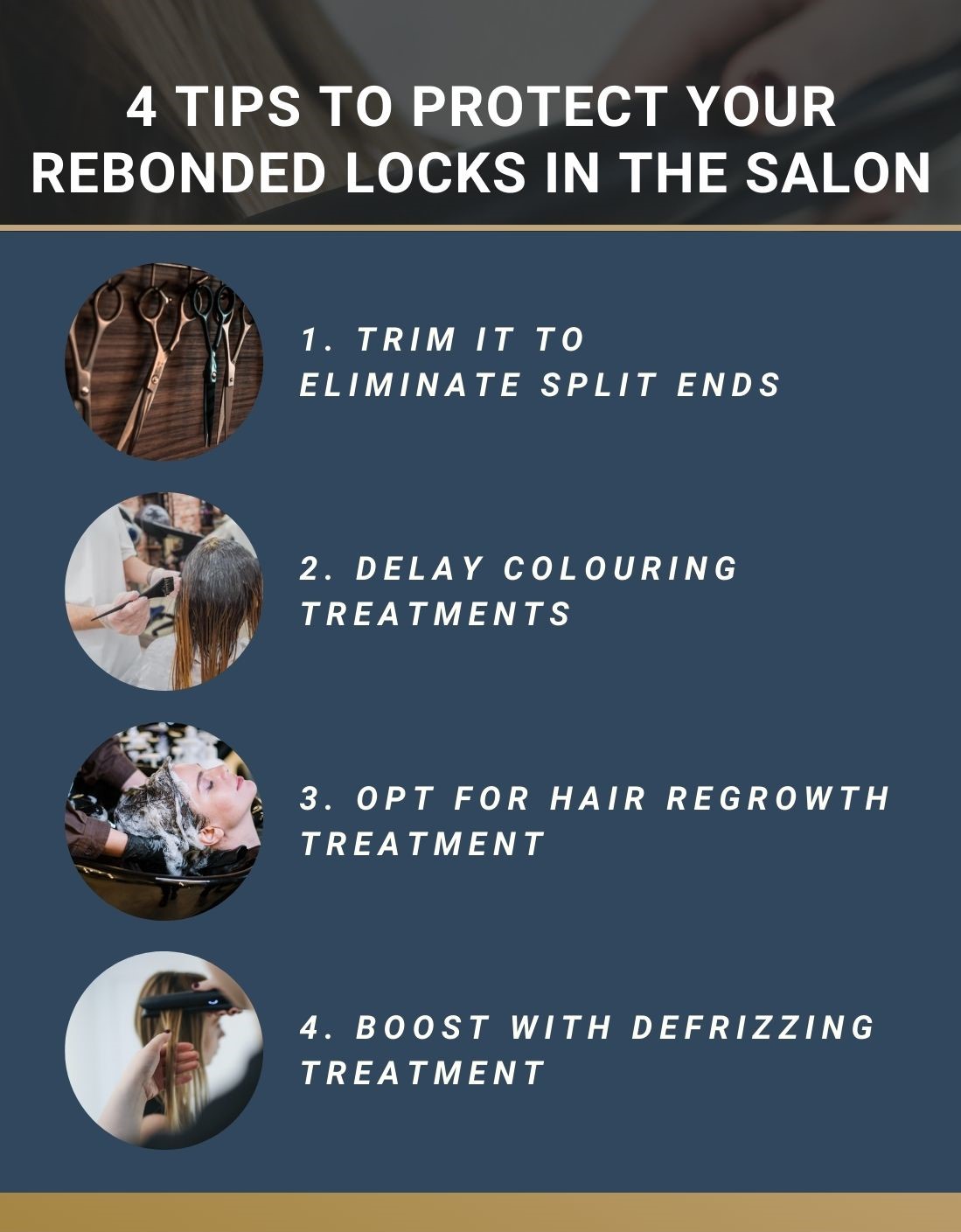
To safeguard your hair and scalp holistically, visit our salon regularly. Let’s take a look at how we can do that in this section, where we’ll cover four tips to help protect your rebonded tresses, from premium treatments to professional haircuts.
At Yoon Salon, we have a variety of high-end treatment and styling options for you here. You should know which ones are absolutely necessary for you to maintain your new luxurious-looking locks, starting with these:
1. Trim It to Eliminate Split Ends
Regularly rid your locks of split ends with a trim. Rebonding can cause damage to your locks, and damage often leads to split ends without sufficient hydration. To do that, visit our adept hairstylists every six to eight weeks to trim the ends of your tresses. Only by doing so will you prevent split ends from travelling up the length of your locks.
2. Avoid Colouring Treatments
For at least a month, consider avoiding any form of harsh chemical treatments, including colouring. You do not want to over-process your tresses and cause further damage. Instead, do check with your stylist on your condition first before you proceed with any treatment.
3. Opt for Premium Hair Treatments
A month later, you can care for your tresses with the right premium hair treatments. Our hairstylists are highly adept at assessing your locks and can advise you on the treatments and professional products you need to go for. You may wish to sign up for regular monthly treatments so your hair can look its absolute best!
4. Maintain Your Rebonded Hair
Most of all, maintenance is key to perfectly rebonded hair all year round. Hair always grows back, so you do need to come down to our salon every month for regular retouches. Your hairstylist can rebond the section nearer to your roots while caring for the rest of your tresses. Feel free to speak with our team of experienced stylists who can tailor these premium services to suit your unique locks.
Your Takeaway
Both salon and home maintenance are critical for rebonded locks. At home, remember to use the right products on your shiny hair so that it is kept within a healthy bubble. Do shampoo and condition it regularly, alongside weekly use of masks and leave-on serums.
You should also never detangle it with a spiral comb and instead, opt for a wide-toothed one. It may sound complicated, but with professional help just a salon away, maintaining your rebonded locks is indeed very easy. Just pop by our salon and our friendly stylists should be able to customise the right care regimen for your chemically treated tresses.
With rebonded hair, never will you have to worry about spending too much time on styling. So why wait? Book an appointment with us at YOON Salon for your rebonding session or for a consultation regarding your hair care needs.


